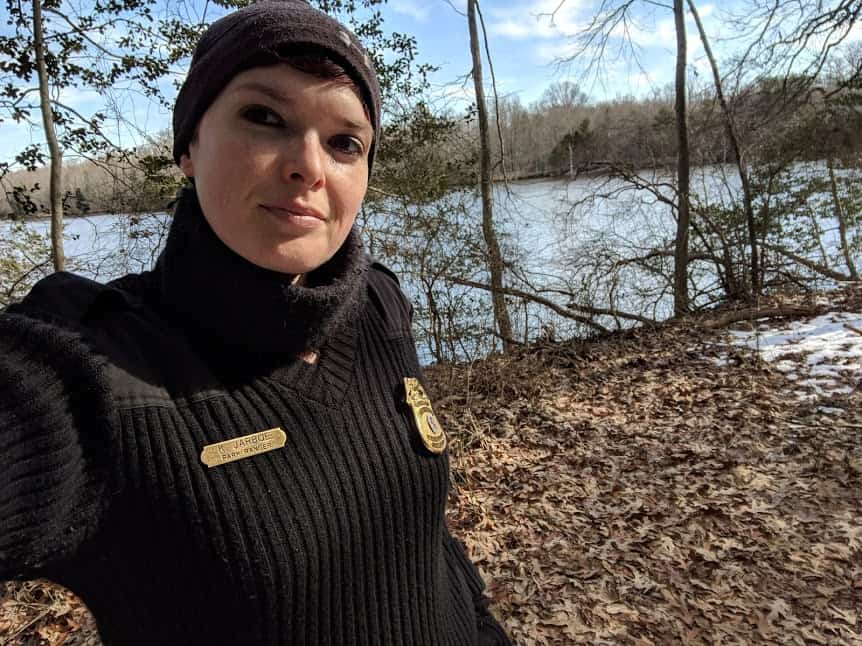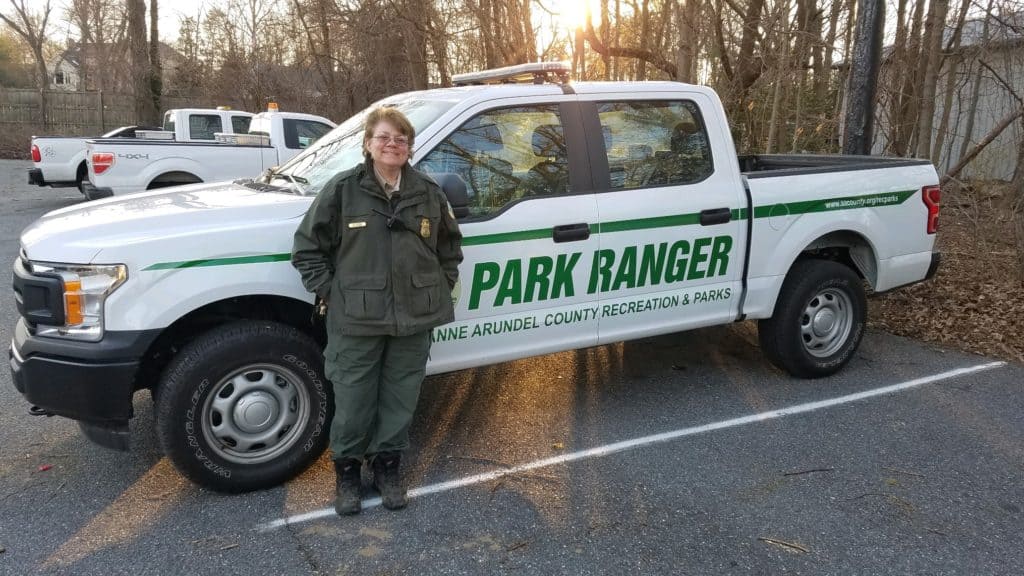Nature’s Caretakers
From top left: Alison Woodfield, Karen Jarboe, Karyn Molines and Sue Payne.
Female rangers lead the way
Whether the uniform is tan, green, gray or blue, park rangers are easy to spot. The iconic hat, sunglasses, badges and boots. You can spot them coming. In Maryland, the person in that uniform is likely to be a woman.
In 1974, Linda Wilkins became the first female park ranger in the state of Maryland. Stationed at Patapsco Valley State Park, she had a background in law enforcement and patrolled the park on foot and on motorcycle.
Wilkins was a ground-breaker in the 70s, and it’s taken time for the rest of the state to catch up. While rangering is still a male-dominated industry, women in outdoor careers are closing the gap.
Anne Arundel County is an inspiring example. Pick a county-owned park and you are likely to find a woman running it. Of our seven county parks, four have women serving as superintendent. The same goes for Calvert County, where the director of Parks and Recreation is female, as are the chiefs of special facilities and natural resources.
Bay Weekly talked to four local women who found their place among the woods, trails, water and beaches of the Chesapeake Bay. Each of these women took a different path to their career, yet all four demonstrate passion and dedication to nature, conservation and education.
Alison Woodfield is celebrating her first anniversary as superintendent at Quiet Waters Park but spent the years prior as a ranger at Sandy Point State Park. “I grew up in the hills of West Virginia and then moved to a rural area of Maryland. We didn’t have neighbors nearby or electronic devices or a television, so I spent my time outdoors with my sister and brother, hunting, fishing and camping.”
Sue Payne has worked in nearly every park in the county and even served as interim superintendent before taking on the role as senior ranger of the Anne Arundel County Trails. Her childhood mirrors Woodfield’s—time spent outdoors. “My father was an outdoorsman. My brother and I were always outdoors, fishing, camping and hiking and all those things that come with it. When I graduated from Severna Park High School, my mom came home with all these catalogs for colleges with programs in wildlife and forestry. She knew me very well.”
Woodfield and Payne left college with degrees that would serve them well in their careers. For others the move to conservation comes long after college.
Karen Jarboe, who was recently named superintendent of the Mayo Peninsula parks, earned her college degree in philosophy. “I had wanted to be a professor of philosophy,” Jarboe says. “But when the economy dried up, those kinds of jobs dry up, too. Thankfully I had made some inroads with the Maryland Park Service after my two years with the Maryland Conservation Corps program.”
Karyn Molines, the Natural Resources Division Chief for Calvert County Parks and Recreation, bounced from being a textiles major to studying zoology under scientific pioneer Dr. Eugenie Clark at the University of Maryland College Park. “In my junior year, I discovered Environmental Education. I learned about the Audubon Naturalist Society in Chevy Chase and started to volunteer with their education department,” says Molines. “I was able to learn from regional experts in every field of natural history: insects, birds, reptiles, amphibians, plants, geology, wetland and forest ecology, and so much more.”
Despite the different paths they took, all these women rarely give gender a second thought in their jobs.
“Thankfully it’s not really shocking to see a female ranger these days,” says Jarboe. “The field is changing. My biggest challenge had been finding fire boots and gloves in my size for when I went to fight wildland fires in California. But today, you could walk into any home improvement store and find gloves, boots and equipment that fit a woman.”
Molines says it was coming from a large family full of entrepreneurs that taught her to be self-sufficient and independent. “I’m the third of six kids. With a large family we all learned how to speak our minds to get noticed and get what we needed or wanted. Both my parents were running a business, so we kids were typically creating our own meals and supporting each other,” she says. “My dad raised us to be feminists, even though he would say that was not his intention.”
During her time conducting scientific research, Molines recalls being the only woman in the room at times. “Having my voice heard was often a challenge, but it never stopped me from being heard. Within Parks & Recreation and overseeing Natural Resources, it is a bit male-dominated, but there are still many strong women leaders.”
All of the rangers we spoke to agree that educating the public is a highlight of the job.
“My favorite part of the job is when I discover something new and get to share it with someone else,” says Payne. “Like spotting a great horned owl nest and finding babies inside and then getting to show someone else. I can see the excitement on their face and know that they are enjoying it, too.”
“For me, it’s combining my love of the outdoors and sharing the outdoors with others—especially children,” says Woodfield. “As a ranger I was given the opportunity to visit schools and talk about my career and introduce children to parks, trails and nature.”
Educational outreach is one way to inspire future female rangers.
Another inroad for female rangers is through service organizations.
“I know a lot of women who came into park careers thanks to their time spent in service organizations like AmeriCorps, and the Conservation Corps,” says Jarboe. “Also, for me personally, it was a welcomed challenge. At first, some older men would say ‘women shouldn’t be doing this work,’ and I’d just reply, ‘well, I’m doing it.’ Now they all know that I know what I’m doing.”
Female rangers are trained just like their male counterparts and are expected to know the same skills. Running a chainsaw, driving a tractor, backing a trailer into the water. “On any given day, you can find me doing maintenance here in the park, running chainsaws or working on plumbing,” says Woodfield.
“Being a ranger is being a Jack-of-all-trades. I write reports, I create budget proposals, I work on trails, I interact with the public. Women are empowered to do more physical jobs now in our culture,” says Jarboe.
Out of town visitors to Jonas Green Park and the B&A Trail remind Sue Payne why she loves her job. “People are recognizing the importance of the outdoors, people want to take care of it, protect it…It’s more than recreation to some people, it promotes a sense of wellbeing, calmness and peacefulness. People come to the outdoors to relax,” she says.
“I feel honored to be here. I like my job so much—if I didn’t like it I wouldn’t have been here so long. Being a park ranger is a terrific job. Yes, you work weekends. Yes, you work holidays. Yes, you work in all kinds of weather— but it is a terrific job.”




